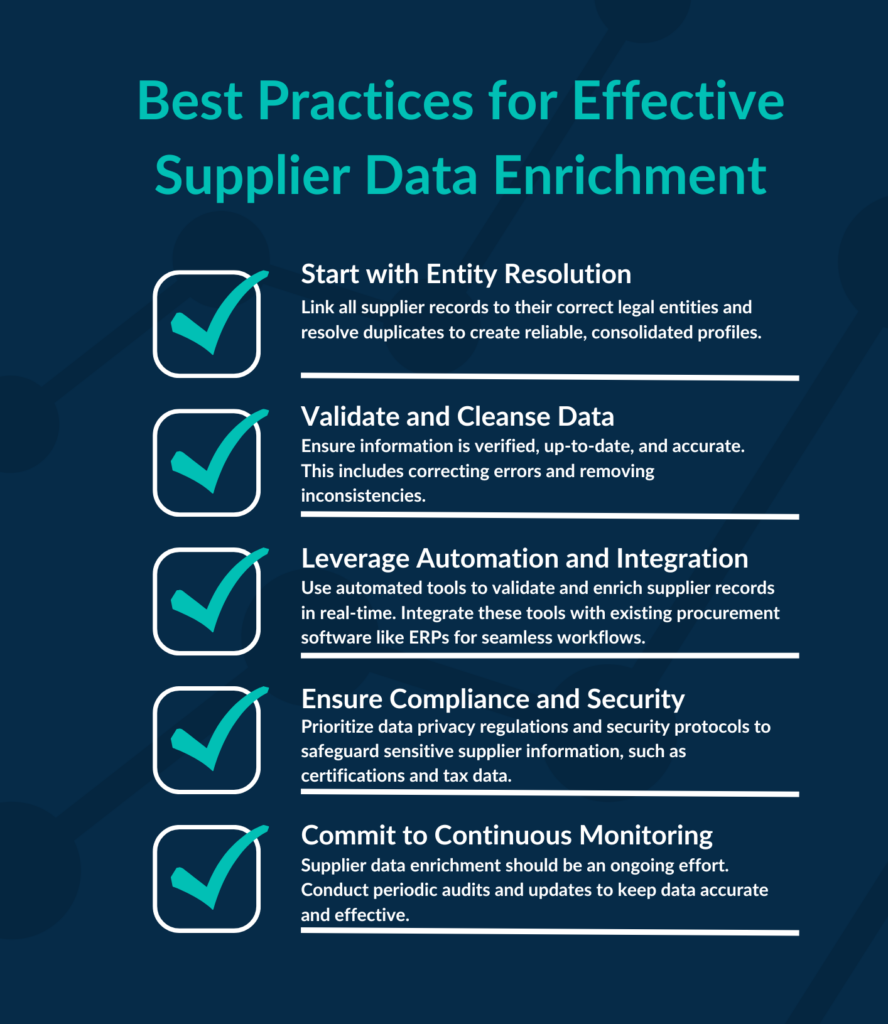Supplier data is key to successful procurement, but many organizations don’t make the most of it. By enhancing their supplier data, organizations can make smarter decisions, manage risks more effectively, build stronger supplier relationships, and drive initiatives like supplier diversity, compliance, and ESG goals.
This guide dives into the importance of supplier data enrichment, its benefits, and how procurement teams can use enriched supplier data to drive strategic objectives.
What is Supplier Data Enrichment?
Why does Supplier Data Enrichment Matter?
What are the Key Benefits of Supplier Data Enrichment?
What are the Challenges with Supplier Data Enrichment?
What are Best Practices for Effective Supplier Data Enrichment?
What is Supplier Data Enrichment?
If you’re in procurement, you likely already have an idea of what supplier data enrichment entails. You might know it as data cleansing or simply updating supplier records. For clarity, let’s define it: Supplier data enrichment is the process of refining raw supplier data by validating, cleaning, and enhancing it with additional information. The result? Deeper insights and a more comprehensive understanding of your suppliers. Enriched supplier data goes beyond basic contact details or category tags—it offers real-time insights into supplier performance, risks, capabilities, and alignment with organizational goals.
Why does Supplier Data Enrichment Matter?
Supplier data enrichment turns scattered, incomplete data into clear, actionable insights. This helps procurement teams to:
- Reduce risks by identifying potential red flags in a supplier’s operational or financial health.
For example, better supplier data can spot warning signs of a key supplier facing financial trouble. This allows the procurement team to quickly switch to another option and avoid expensive disruptions.
- Build stronger relationships by gaining deeper insights into supplier capabilities and performance metrics. By quickly identifying a supplier’s strengths and offerings, organizations can collaborate more effectively on process improvements, set clear expectations, and foster open communication. This approach enhances trust, boosts efficiency, and creates a more reliable and resilient supply chain.
- Source new suppliers faster by having access to up-to-date, reliable information.
For instance, with enriched supplier data, a company can spot if one of its key suppliers is heading for financial trouble and quickly switch to another option, saving time and money.
- Consolidate suppliers by merging duplicate or fragmented supplier records into a unified profile. This streamlines operations, enhances pricing negotiations, and lowers administrative costs.
- Advance diversity and sustainability goals through accurate tracking of diverse and ESG-compliant suppliers, and better ways to source new diverse suppliers.
Enhancing supplier data can turn your supplier operations into a real competitive edge, making procurement smarter, more efficient, and more sustainable.
What are the Key Benefits of Supplier Data Enrichment?
Enriched supplier data brings real, measurable benefits that can improve procurement processes and strategies in many ways:
1. Improved Risk Management
Enriched data helps mitigate supplier risks proactively.
- Access third-party risk indicators to flag suppliers with shell companies or foreign control.
- Conduct continuous assessments using real-time data on geopolitical risks and compliance updates.
- Identify compliance violations to ensure suppliers meet certifications, ethical standards, and trade agreements.
2. Enhanced Supplier Relationship Management
Strong supplier relationships stem from clear and meaningful insights.
- Simplify communication and improve alignment through data-backed supplier profiles.
- Gain visibility into performance trends and use this information for collaborative enhancements.
- Negotiate effectively with up-to-date knowledge of supplier capabilities and history.
3. Streamlined Processes
- Centralize supplier data for easy access across teams and departments.
- Automate supplier qualification processes to cut lead times and reduce redundancies.
- Quickly locate suppliers by leveraging high-quality, enriched data tailored to your requirements.
4. Driving Supplier Diversity and ESG Goals
- Identify and track underrepresented suppliers with verified diversity certifications.
- Assess environmental impact and labor practices of suppliers to align with ESG goals.
- Accurately report ESG and diversity metrics to meet governance and stakeholder requirements.
When procurement teams work with richer datasets, supplier data enrichment delivers long-term value that supports core business objectives.
What are the Challenges with Supplier Data Enrichment?
The benefits of supplier data enrichment are clear, but adopting it does come with its own challenges.
Data Quality and Integrity Issues
Without regular data validation, supplier vendor master data can quickly fill up with outdated, duplicate, or incorrect information. Cleaning up old systems can take a lot of time and effort, but without clean data, every other improvement you try to make will fall short.
Cost and Time Constraints
Supplier data enrichment can be resource-intensive, particularly for smaller procurement teams operating under tight budgets. To offset this, organizations can look to automation tools that reduce manual workloads and long-term costs.
What are Best Practices for Effective Supplier Data Enrichment?
To create a strong foundation for smarter procurement, businesses should follow these steps:
1. Initiate with Entity Resolution
Link all supplier records to their correct legal entities and resolve duplicates to create reliable, consolidated profiles.
2. Validate and Cleanse Data
Ensure information is verified, up-to-date, and accurate. This includes correcting errors and removing inconsistencies.
3. Leverage Automation and Integration
Use automated tools to validate and enrich supplier records in real-time. Integrate these tools with existing procurement software like ERPs for seamless workflows.
4. Ensure Compliance and Security
Prioritize data privacy regulations and security protocols to safeguard sensitive supplier information, such as certifications and tax data.
5. Commit to Continuous Monitoring
Supplier data enrichment should be an ongoing effort. Conduct periodic audits and updates to keep data accurate and effective.

Build Smarter Procurement with Supplier Data Enrichment
Supplier data enrichment isn’t just a “nice-to-have” anymore—it’s a must for procurement teams looking to streamline processes, manage risks, and build stronger, value-driven supplier relationships. It also opens doors for key initiatives like ESG compliance and supplier diversity, helping align procurement with long-term business goals.
